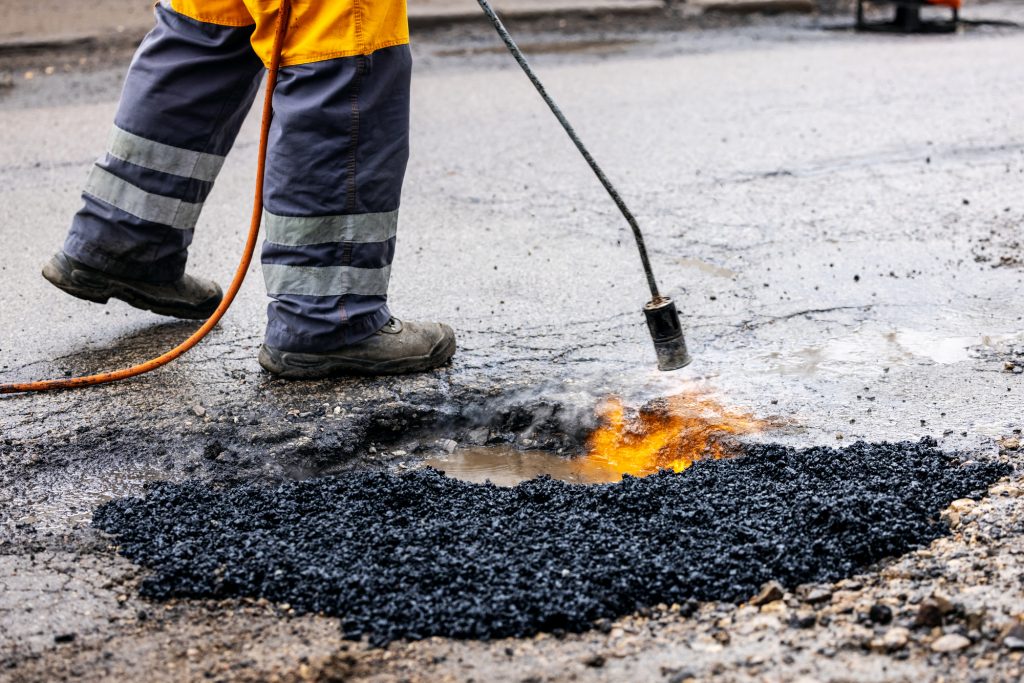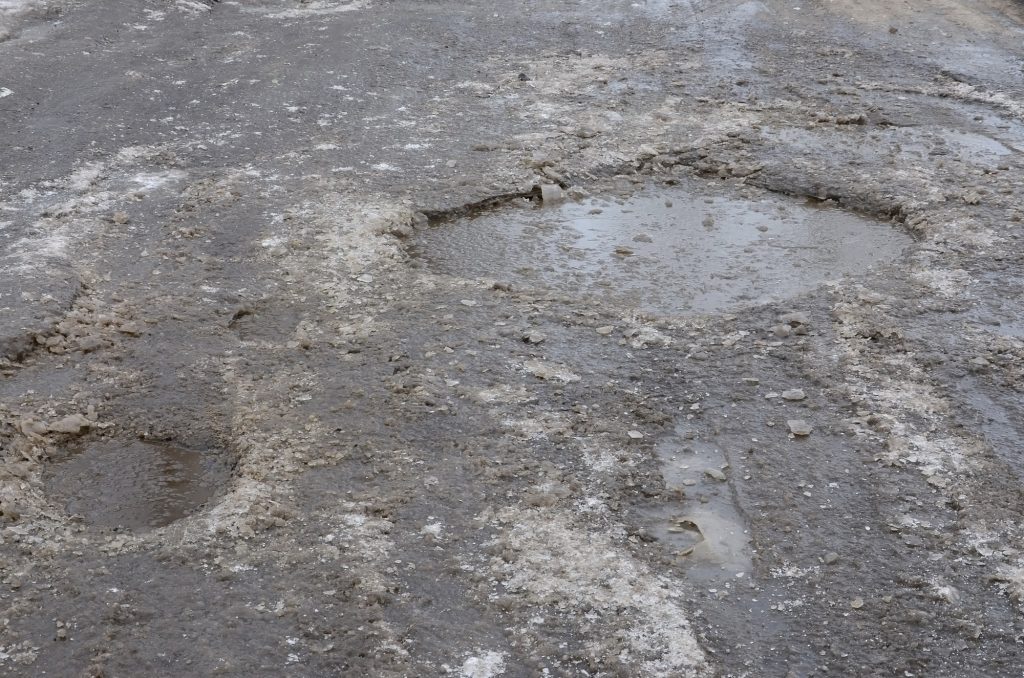
Commercial Pothole Repair Services
Potholes are a pain for any property manager. They make parking lots unappealing at shopping centers and office buildings. Residents complain about them at multifamily properties. They make properties less safe. According to a AAA study, potholes damage over 3,000,000 cars every year. On average, it costs $300 to repair vehicle damage caused by a pothole. When a pothole forms, it is only a matter of time before it must be fixed. As a result, reliable commercial pothole repair services are extremely important to any property manager.
Thankfully, most commercial asphalt contractors fix potholes. There are also pothole repair companies, that concentrate specifically on this type of work. In certain situations, potholes can be repaired temporarily by in-house maintenance professionals using specialty products. Keep reading to learn more about potholes, why they form, and how they can be repaired, or click here to get a pothole repair quote from Property Manager Insider’s BidSource team!
Why Do Potholes Form?
Potholes are everywhere. They can be found in Boston, Miami, Seattle, Los Angeles and everywhere in between. It doesn’t matter if the climate is hot or cold. It doesn’t matter if you are taking about a shopping center in the suburbs or an urban parking lot. Potholes almost always appear.
So, why do potholes form all over the country? There are three core factors that cause potholes:
- Asphalt is a synthetic material that deteriorates over time
- Wear and tear from vehicle traffic reduces the life of asphalt
- Natural elements damage and break down asphalt
The combination of these factors, make potholes virtually unavoidable. This is true regardless of climate, as potholes form in both warm and cold climates. As a result, property managers should have a reliable pothole repair contractor available to fix potholes when they inevitably show up.

Cold Weather Potholes
Potholes occur in cold climates because of freeze thaw cycles. First, heavy use begins to breakdown the asphalt over time. This generally appears as cracks in the asphalt surface. Next, water from rain, snow, sleet, or melting ice, penetrates the asphalt. When temperatures fluctuate, this water freezes, which causes it to expand and contract. Over time, the expansion from the freeze thaw cycle damages the asphalt subsurface. Eventually, the asphalt weakens to the point where vehicle traffic displaces pieces of the asphalt forming a pothole.
Another challenge in cold weather climates is the use of salt in snow and ice treatments. Pure water freezes at 32 degrees while saltwater freezes at low temperatures based on salinity. If the freezing point for saltwater caused by ice treatments and melting snow is 20 degrees, this subjects the asphalt to more rapid freeze thaw cycles. When the temperatures hit 15 degrees, then rise to 25 degrees, the saltwater in the asphalt goes through a freeze thaw cycle while pure water would’ve remained frozen the entire time.
Warm Weather Potholes
Potholes occur in warm climates because of heavy traffic use, heat, and water. Just like cold weather potholes, the first step in warm weather potholes is a break down in the asphalt surface caused by traffic use. As cracks form, water penetrates the asphalt surface. Unlike cold climates where freeze thaw cycles damage asphalt, water penetrations in warm weather climates breakdown the subsurface over time. The weakened subsurface makes the asphalt surface more susceptible to damage from vehicle traffic. Overtime, continued use and a weakened subsurface lead to potholes.
While asphalt in warm climates does not have to deal with freeze thaw cycles, it is under constant heat caused by high temperatures. Prolonged intense heat, think summer time in Florida, Georgia or South Carolina, contributes to asphalt deterioration. Just because there are no snow storms or ice treatments in Miami, doesn’t mean the elements do not contribute to potholes.
Are Potholes Really That Bad?
While a small pothole might not seem like a big problem, ignoring it will only make the situation worse. Potholes always get worse over time. Constant vehicle traffic near a small pothole continually weakens the surrounding asphalt. Eventually the asphalt cracks causing the pothole to grow in size. As a result the pothole becomes more hazardous and expensive to repair. This is one reason why fixing small potholes right away is important.
Potholes can also cause other major problems for property managers and owners such as lawsuits, low tenant retention, insurance claims, and car accidents. This is because potholes reduce property’s curb appeal, create unsafe parking lot conditions, and damage vehicles.
Potholes Hurt Curb Appeal
Other than asphalt contractors, no one gets excited when they see a parking lot, driveway, or road surface covered in potholes. They are unattractive eye sores that hurt the aesthetic appearance of any property’s asphalt surfaces. Put bluntly, potholes can kill a commercial property’s curb appeal. Failing to repair a pothole over a long period of time can have trickle down effects that make it harder to retain tenants and lease new ones.
For multifamily properties, a parking lot covered in potholes can lower resident retention and make it harder to attract new renters. This is because no one wants to use a parking lot that is covered in potholes. Potholes can generate complaints from both tenants and visitors at shopping centers, office parks, and other commercial properties. Potholes can be a particular problem for shopping centers, as some consumers will simply not visit a shopping center if they know the parking lot is in poor condition. This can hurt retail businesses already struggling to generate foot traffic.
Parking Lot Safety Issues
Potholes, large or small, create safety issues at any property where tenants and visitors are driving and parking cars. This is true for office buildings, shopping centers, and multifamily properties among others. Cars will often swerve to avoid potholes, which can lead to accidents. This can include hitting other moving cars, parked cars, property such as shopping cart returns or EV charging stations, or in the worst case scenario, pedestrians.
Potholes by their very nature are trip hazards. They create uneven surfaces which can cause injuries and depending on the severity of the fall, personal injury lawsuits. While this might sound far fetched, two properties in Florida were sued for damages related to trip and fall injuries caused by potholes. Fixing potholes makes any parking lot safer and helps properties avoid personal injury lawsuits.
Potholes Damage Cars
In addition to the cosmetic and safety issues caused by potholes, they are also a danger to vehicles. This is because hitting a pothole, at any speed, can damage a vehicle. Potential vehicle damage caused by potholes includes:
- Tire Damage/Flat Tires
- Axle Misalignment
- Suspension Damage
- Strut and Shock Damage
- Scrapes, Paint Chips, and Dents
- Bent Exhaust Pipes
In most cases, damage to cars and trucks caused by potholes is covered by a vehicle’s insurance company if they have collision coverage. Unfortunately, this does not mean the property is automatically not responsible or legally liable for the damage. According to LegalZoom, a vehicle owner can file a premises liability claim against private property owners for damages and injuries resulting from the pothole. This is another reason repairing potholes at commercial properties is extremely important.
Fixing Potholes at Commercial Properties
According to the American Automobile Association, potholes cause over $3,000,000,000 in damage to vehicles in the United States every year. In addition to the vehicle damage they cause, potholes create safety and liability issues at commercial properties. All in all, potholes can give property managers major headaches! As a result, fixing potholes at commercial properties is extremely important.
There are two main types of pothole repairs, cold patch and hot patch. As their names indicate, one uses cold asphalt materials and one uses hot asphalt materials to fill the pothole in question. There are benefits and drawbacks to both methods, which are explained in depth below. Need to fix a pothole at your property? Request a quote from a certified asphalt contractor Property Manager Insider’s BidSource network!
Hot Patch Pothole Repairs
Hot patch pothole repairs are the most effective way to permanently fill and fix a pothole. The process requires the professional expertise of a commercial asphalt contractor. This is because of the equipment, skills, and knowledge required to complete a hot patch pothole repair. Here’s how hot patch asphalt repairs work:
- Asphalt around the pothole is excavated creating a larger opening
- Any damage to the parking lot subsurface is repaired
- Potholes are filled my hot mix asphalt
- Hot mix asphalt is tamped level and seal coated
Using the hot patch repair process is generally the best way to fix a pothole. They are a permanent fix and ensure potholes will not redevelop in the same section of the parking.
Pro’s of Hot Patch Pothole Repairs
Done correctly, a hot patch repair permanently guarantees a pothole will not re-emerge in the same area of the parking surface. This is the biggest benefit and reason to use hot patch asphalt to fix a pothole. They can also be used to fix potholes of any size and depth. Hot patch repairs can also be seal coated immediately, which adds a layer of protection to the fresh asphalt surface. Pro’s of hot patch pothole repairs include:
- Permanent solution guaranteeing potholes won’t reappear
- Repairs the parking lot subsurface in addition to the parking surface
- Seal coated immediately after the hot patch is applied
- Can be used to fix potholes of almost any size and depth
When weather permits, hot patch asphalt repairs are usually the best solution. They are a permanent fix and assure potholes won’t reemerge in the same spot. They are an especially good option for newer parking lots that won’t be repaved for many years.
Cons of Hot Patch Pothole Repairs
While filling a pothole with hot asphalt has numerous benefits, it also has its drawbacks. The biggest issue with hot patch repairs are the weather requirements. Hot patch repairs require warm, dry temperatures, usually over 50 degrees. This makes them impossible to complete during the winter in many parts of the country. Additionally, they are more expensive than cold patch repairs and must be performed by a commercial asphalt contractor. Cons of hot patch pothole repairs include:
- More expensive option compared to cold patch repairs
- Require warm, dry weather. Can’t be completed in the winter
- No DIY option, must be done by a commercial paving contractor
In short, hot patch asphalt repairs are generally the best option for commercial property managers. While there are drawbacks to repairing commercial potholes with hot patch asphalt, they are a permanent solution. As a result, when the weather permits, a hot patch asphalt repair is the best way to fix potholes in commercial parking lots.
Cold Patch Pothole Repairs
Cold patch pothole repairs are an effective way to temporarily fix potholes. Filling a pothole with cold patch asphalt is a straight forward process. In cases involving very small potholes, a property manager can ask maintenance personnel to apply the patch. Here’s how cold patch pothole repairs work:
- Clean the pothole or loose materials and debris
- Fill the pothole with cold patch asphalt mix
- Tamp the cold patch asphalt to completely fill the pothole
- Roll the tamped cold patch asphalt with a car tire
After the repair, the filled pothole should have a small crown that will smooth out over time. If a filled pothole starts to cave in, more cold patch can be applied and tamped to keep it level with the rest of the parking lot. In most cases, the asphalt surface can be used immediately after the pothole is filled with cold patch.
Pro’s of Cold Patch Asphalt Repairs
Like any other type of repair, fixing a pothole with cold patch asphalt has both pro’s and cons. While hot patch asphalt repairs require minimum temperatures over 40 degrees, cold patch can be used to fill potholes in any temperature. This is the biggest benefit of cold patch asphalt repairs. There are situations where they are the only option. Another benefit of cold patch asphalt repairs is their affordability. In general, they are less expensive than hot patch repairs. Pro’s of cold patch asphalt repairs:
- Affordable, less expensive than hot patch repairs
- Year round use even in cold winter weather
- Easy repair process requiring no special equipment
- Possibly DIY repair by a maintenance professional or handyman
In conclusion, cold patch repairs are the best option for emergency pothole repairs in cold weather climates. They are also a good option when budget and affordability matter. Lastly, because cold patch pothole repairs are less expensive short-term fixes, they make sense if a property is planning to mill and overlay the entire parking lot in the near future.
Cons of Cold Patch Asphalt Repairs
While there are numerous reasons to use cold patch to fix a pothole, the process also has its drawbacks. First and foremost, it is not a permanent fix. In many cases, cold patch pothole repairs will only last one or two seasons. Over time, the pothole will reappear, and ultimately require a more permanent repair. Cold patch asphalt repairs are also designed for small, low depth potholes. Products like Sakrete’s cold patch mix are not recommended for potholes over 4″ deep. Another drawback of cold patch repairs is the cure time. While cold patch repairs can be driven over almost immediately, the product typically takes 30 days to cure. The cold patch can’t be seal coated until it has completed cured. This is a drawback compared to hot patch pothole repairs which can be seal coated almost immediately. Cons of cold patch pothole repairs:
- Short life, usually lasting one or two seasons
- Eventually require a permanent solution
- Designed for smaller, low depth potholes
- Must wait to seal coat repaired potholes
In general, cold patch pothole repairs are a great quick fix. They are affordable and can be used year-round in any temperature. While they have their drawbacks and limitations, they are an excellent option to repair potholes when a hot patch repair is not in the budget or feasible because of the weather.
Get A Pothole Repair Estimate
Property managers can use BidSource to have the Property Manager Insider team locate a qualified commercial contractor for their next project or service call. Just fill out the form with your project details and a member of our team will be in touch.


